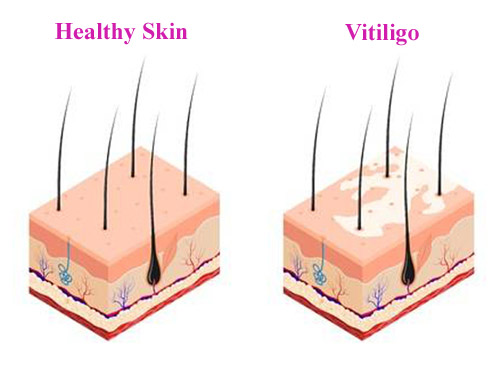Vitiligo

Published: 18 Jun 2025
ICD9: 709.01 ICD10: L80 ICD11: ED63.0
Vitiligo is a condition that causes loss of pigment in the skin, resulting in white patches.
These patches can appear anywhere on the body and are most noticeable on areas exposed to the sun.
Here's a breakdown of what vitiligo is:
![]() Loss of Pigment: The primary cause of vitiligo is the destruction or malfunction of melanocytes. Melanocytes are cells responsible for producing melanin, the pigment that gives skin, hair, and eyes their color.
Loss of Pigment: The primary cause of vitiligo is the destruction or malfunction of melanocytes. Melanocytes are cells responsible for producing melanin, the pigment that gives skin, hair, and eyes their color.
![]() White Patches: The hallmark symptom is the appearance of depigmented, white or pale patches on the skin. These patches can vary in size and shape.
White Patches: The hallmark symptom is the appearance of depigmented, white or pale patches on the skin. These patches can vary in size and shape.
![]() Any Location: Vitiligo can affect any part of the body, including the face, neck, hands, feet, and areas around body openings. It can also affect mucous membranes, such as the tissues inside the mouth and nose, and even hair.
Any Location: Vitiligo can affect any part of the body, including the face, neck, hands, feet, and areas around body openings. It can also affect mucous membranes, such as the tissues inside the mouth and nose, and even hair.
![]() Not Contagious: Vitiligo is not contagious. You cannot catch it from touching someone who has it.
Not Contagious: Vitiligo is not contagious. You cannot catch it from touching someone who has it.
![]() Autoimmune Component: Vitiligo is often considered an autoimmune disorder, where the body's immune system mistakenly attacks and destroys its own melanocytes.
Autoimmune Component: Vitiligo is often considered an autoimmune disorder, where the body's immune system mistakenly attacks and destroys its own melanocytes.
![]() Variable Progression: The progression of vitiligo varies greatly from person to person. Some people may develop only a few small patches, while others experience more widespread pigment loss. It can also spread slowly over many years or rapidly.
Variable Progression: The progression of vitiligo varies greatly from person to person. Some people may develop only a few small patches, while others experience more widespread pigment loss. It can also spread slowly over many years or rapidly.
![]() Impact on Quality of Life: While vitiligo is not life-threatening, it can significantly impact a person's self-esteem and psychological well-being due to the visible skin changes.
Impact on Quality of Life: While vitiligo is not life-threatening, it can significantly impact a person's self-esteem and psychological well-being due to the visible skin changes.
Key things to remember:
![]() Vitiligo is a skin condition characterized by loss of pigment.
Vitiligo is a skin condition characterized by loss of pigment.
![]() It is not contagious.
It is not contagious.
![]() It is often considered an autoimmune disorder.
It is often considered an autoimmune disorder.
![]() It can affect any part of the body.
It can affect any part of the body.
If you suspect you have vitiligo, it's important to see a dermatologist for diagnosis and treatment options.